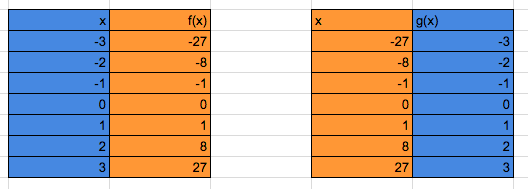Understanding the Concept of Inverse Functions
Let us consider the functions
and
.
The table on the left shows the ordered pairs . We used
and substitute them to
in the second table.

As we can see, all the values of are the same as those of
in the first table. For example, if we have
in the first table, applying
, we get 27 as output. On the other hand, if we apply
to 27, the value returns to
.
3 ——— f ———>27 ———-g ———>3
From the tables above, we can see that it also does this to other values. Thus, we can say that it seems that the function is an”undo” for
.
In mathematics, functions such as and
, are called inverse functions. In mathematical notation, if
and
are inverse functions, we can replace the notation of
as
making it
From this notation we can say that
is the inverse of
.
Please take note that is not the same as f raised to negative one.
Let us try to look at the ordered pairs above from the two functions.
(-3,-27) and (-27,-3)
(-2, -8) and (-8, -2)
(-1, -1) and (-1, -1)
and so on, we can say that the if has ordered pairs
its corresponding ordered pair in
is
.
From the discussion above and looking at the tables, we can see that
(1) the domain of is the same as the range of
.
(2) the range of is the same as the domain of
.
(3) the corresponding pair of in
is
in
.
From the discussion above, we can ask the following questions.
(1) What are the properties of inverse functions and its graphs?
(2) Do all functions have inverses?
(3) If a function has an inverse, how do we find it?
These are the topics that we are discuss in the next few posts.